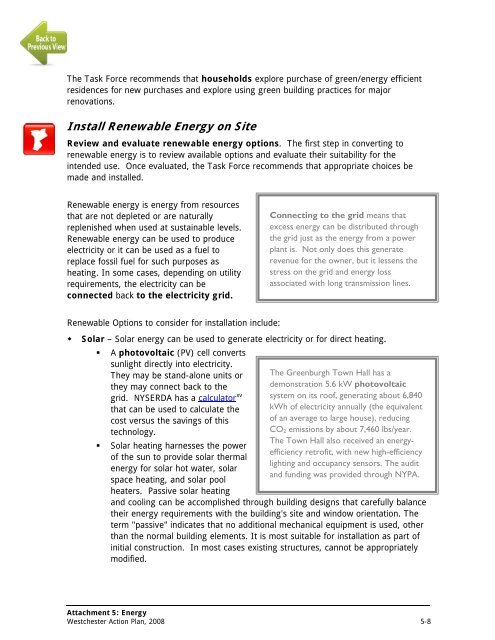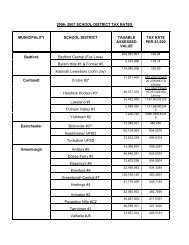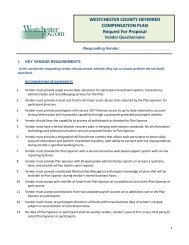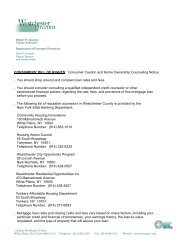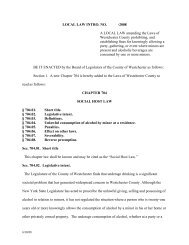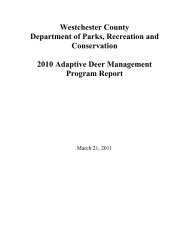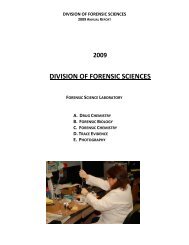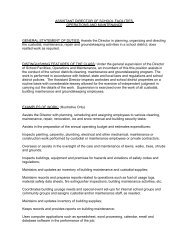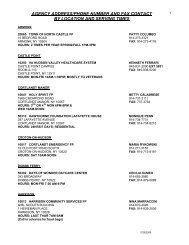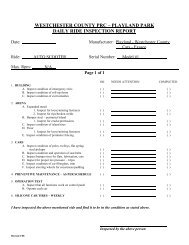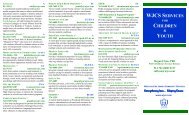Westchester Action Plan, 2008 - Westchester County Government
Westchester Action Plan, 2008 - Westchester County Government
Westchester Action Plan, 2008 - Westchester County Government
Create successful ePaper yourself
Turn your PDF publications into a flip-book with our unique Google optimized e-Paper software.
The Task Force recommends that households explore purchase of green/energy efficient<br />
residences for new purchases and explore using green building practices for major<br />
renovations.<br />
Install Renewable Energy on Site<br />
Review and evaluate renewable energy options. The first step in converting to<br />
renewable energy is to review available options and evaluate their suitability for the<br />
intended use. Once evaluated, the Task Force recommends that appropriate choices be<br />
made and installed.<br />
Renewable energy is energy from resources<br />
that are not depleted or are naturally<br />
replenished when used at sustainable levels.<br />
Renewable energy can be used to produce<br />
electricity or it can be used as a fuel to<br />
replace fossil fuel for such purposes as<br />
heating. In some cases, depending on utility<br />
requirements, the electricity can be<br />
connected back to the electricity grid.<br />
Connecting to the grid means that<br />
excess energy can be distributed through<br />
the grid just as the energy from a power<br />
plant is. Not only does this generate<br />
revenue for the owner, but it lessens the<br />
stress on the grid and energy loss<br />
associated with long transmission lines.<br />
Renewable Options to consider for installation include:<br />
• Solar – Solar energy can be used to generate electricity or for direct heating.<br />
• A photovoltaic (PV) cell converts<br />
sunlight directly into electricity.<br />
They may be stand-alone units or<br />
they may connect back to the<br />
grid. NYSERDA has a calculator xv<br />
that can be used to calculate the<br />
cost versus the savings of this<br />
technology.<br />
• Solar heating harnesses the power<br />
of the sun to provide solar thermal<br />
energy for solar hot water, solar<br />
space heating, and solar pool<br />
heaters. Passive solar heating<br />
The Greenburgh Town Hall has a<br />
demonstration 5.6 kW photovoltaic<br />
system on its roof, generating about 6,840<br />
kWh of electricity annually (the equivalent<br />
of an average to large house), reducing<br />
CO 2 emissions by about 7,460 lbs/year.<br />
The Town Hall also received an energyefficiency<br />
retrofit, with new high-efficiency<br />
lighting and occupancy sensors. The audit<br />
and funding was provided through NYPA.<br />
and cooling can be accomplished through building designs that carefully balance<br />
their energy requirements with the building's site and window orientation. The<br />
term "passive" indicates that no additional mechanical equipment is used, other<br />
than the normal building elements. It is most suitable for installation as part of<br />
initial construction. In most cases existing structures, cannot be appropriately<br />
modified.<br />
Attachment 5: Energy<br />
<strong>Westchester</strong> <strong>Action</strong> <strong>Plan</strong>, <strong>2008</strong> 5-8


